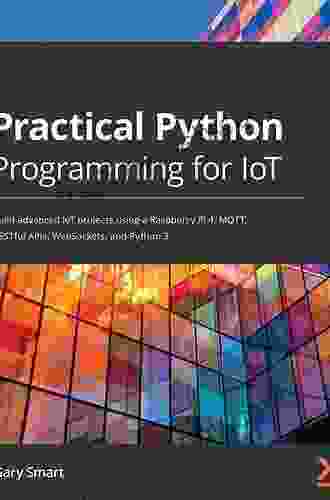Unlock the Power of IoT with Practical Python Programming

In the ever-evolving landscape of technology, the Internet of Things (IoT) has emerged as a transformative force, connecting devices, collecting data, and enabling automation like never before. Python, a versatile programming language known for its simplicity and efficiency, has become the go-to choice for IoT development. This article will delve into the practical aspects of Python programming for IoT, providing you with the knowledge and guidance to create innovative and impactful IoT solutions.
Python's popularity in the IoT domain is attributed to its numerous advantages:
- Simplicity and Readability: Python's syntax is straightforward and easy to learn, making it accessible to programmers of all skill levels.
- Versatility: Python offers a wide range of libraries and modules specifically designed for IoT development, such as PySerial, paho-mqtt, and boto3.
- Cross-Platform Compatibility: Python is compatible with various operating systems, including Windows, Linux, and macOS, allowing you to develop IoT solutions for diverse platforms.
- Community Support: Python boasts a vast and active community of developers, providing ample resources, tutorials, and forums for support and collaboration.
To embark on your Python programming for IoT journey, follow these steps:
4.4 out of 5
| Language | : | English |
| File size | : | 32504 KB |
| Text-to-Speech | : | Enabled |
| Screen Reader | : | Supported |
| Enhanced typesetting | : | Enabled |
| Print length | : | 516 pages |
- Install Python: Download and install the latest version of Python from its official website.
- Setup IoT Environment: Choose an IoT platform and set up your hardware devices. We recommend platforms like Raspberry Pi or Arduino.
- Install IoT Libraries: Install Python libraries for IoT development, such as PySerial for serial communication, paho-mqtt for MQTT messaging, and boto3 for cloud services integration.
- Data Collection: Python can interface with sensors and actuators to collect data from the physical world.
- Data Processing: You can use Python's data analysis libraries, such as NumPy and Pandas, to process and analyze the collected data.
- Data Visualization: Create insightful visualizations using Python's graphing library, Matplotlib, to gain valuable insights from the data.
- Device Control: Python enables you to control IoT devices remotely by sending commands to actuators or controlling GPIO pins.
- Cloud Connectivity: Integrate IoT devices with cloud services using Python libraries like boto3 to store and manage data, leverage AI, and enable remote device management.
- Home Automation: Build a smart home system that controls lights, switches, and appliances using Python and Raspberry Pi.
- Environmental Monitoring: Create a device that monitors temperature, humidity, and air quality using Python and an Arduino board.
- Remote Device Management: Develop a Python application for remotely controlling and monitoring IoT devices connected to a cloud platform.
Python programming is an indispensable skill for IoT developers. Its simplicity, versatility, and extensive ecosystem empower you to create powerful and innovative IoT solutions. By understanding the key concepts and following the practical examples outlined in this article, you can unlock the full potential of IoT and transform your ideas into reality.
Mastering Python for IoT will enable you to:
- Empower IoT Devices: Give IoT devices the ability to collect data, process information, and communicate wirelessly.
- Maximize Device Interoperability: Connect devices from various manufacturers and protocols using Python's capabilities.
- Simplify Data Management: Collect, store, and analyze data from multiple IoT devices in a structured and efficient manner.
- Build Scalable Solutions: Create IoT systems capable of handling large amounts of data and multiple devices simultaneously.
- Unlock the Potential of IoT: Leverage the transformative power of IoT to automate tasks, improve efficiency, and create new possibilities.
Embark on your Python programming for IoT journey today and harness the power of this versatile language to shape the future of connected systems.
4.4 out of 5
| Language | : | English |
| File size | : | 32504 KB |
| Text-to-Speech | : | Enabled |
| Screen Reader | : | Supported |
| Enhanced typesetting | : | Enabled |
| Print length | : | 516 pages |
Do you want to contribute by writing guest posts on this blog?
Please contact us and send us a resume of previous articles that you have written.
 Book
Book Novel
Novel Page
Page Chapter
Chapter Text
Text Story
Story Genre
Genre Reader
Reader Library
Library Paperback
Paperback E-book
E-book Magazine
Magazine Newspaper
Newspaper Paragraph
Paragraph Sentence
Sentence Bookmark
Bookmark Shelf
Shelf Glossary
Glossary Bibliography
Bibliography Foreword
Foreword Preface
Preface Synopsis
Synopsis Annotation
Annotation Footnote
Footnote Manuscript
Manuscript Scroll
Scroll Codex
Codex Tome
Tome Bestseller
Bestseller Classics
Classics Library card
Library card Narrative
Narrative Biography
Biography Autobiography
Autobiography Memoir
Memoir Reference
Reference Encyclopedia
Encyclopedia N Davis
N Davis Helen Ketteman
Helen Ketteman Jessica Dunham
Jessica Dunham Helen K Emms
Helen K Emms Hirotaka Kisaragi
Hirotaka Kisaragi Mike Rother
Mike Rother Ian Bremmer
Ian Bremmer Nsca National Strength Conditioning Association
Nsca National Strength Conditioning Association Henry Lewis Suggs
Henry Lewis Suggs Melissa Fehr
Melissa Fehr Richelle Putnam
Richelle Putnam Hrishikesh Joshi
Hrishikesh Joshi Jenny Landreth
Jenny Landreth Ian Boothby
Ian Boothby Igor Ryzov
Igor Ryzov Ivy Hope
Ivy Hope Helene Henderson
Helene Henderson Jon Dunn
Jon Dunn Ellen Berry
Ellen Berry Hilary Spurling
Hilary Spurling
Light bulbAdvertise smarter! Our strategic ad space ensures maximum exposure. Reserve your spot today!

 Floyd RichardsonEasy And Short Lessons For Beginners To Learn Pronunciation, Grammar, Verbs...
Floyd RichardsonEasy And Short Lessons For Beginners To Learn Pronunciation, Grammar, Verbs... Jacob FosterFollow ·2.9k
Jacob FosterFollow ·2.9k Logan CoxFollow ·7.7k
Logan CoxFollow ·7.7k Xavier BellFollow ·3.1k
Xavier BellFollow ·3.1k Reginald CoxFollow ·2.1k
Reginald CoxFollow ·2.1k Holden BellFollow ·17.9k
Holden BellFollow ·17.9k Fred FosterFollow ·14.7k
Fred FosterFollow ·14.7k Jeremy CookFollow ·14.6k
Jeremy CookFollow ·14.6k Kirk HayesFollow ·3.4k
Kirk HayesFollow ·3.4k

 Bo Cox
Bo CoxUncover the Enchanting Pearl of the Arabian Gulf: Insight...
Escape to the opulent...

 Michael Crichton
Michael CrichtonInsight Guides Pocket Baku Travel Guide Ebook: Your...
An Enchanting Journey...

 Eugene Scott
Eugene ScottLearn to Paint Scenic Scenes: Unveil the Secrets of...
Step into the...

 Benji Powell
Benji PowellEmbark on a Culinary Adventure with "The Ultimate Sichuan...
Sichuan cuisine,...

 Finn Cox
Finn CoxDiscover the Enchanting World of Art Nouveau: A...
Immerse yourself in the captivating beauty...

 Corey Green
Corey GreenUncover the Vibrant World of Guatemalan Chicken Buses: An...
Step into a world of vibrant colors,...
4.4 out of 5
| Language | : | English |
| File size | : | 32504 KB |
| Text-to-Speech | : | Enabled |
| Screen Reader | : | Supported |
| Enhanced typesetting | : | Enabled |
| Print length | : | 516 pages |










